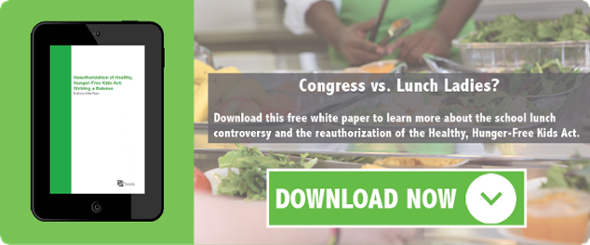 Food insecurity in children is a significant problem in the United States. According to United States Department of Agriculture (USDA) estimates, 7.8 percent of American households with children were food insecure* in 2015 – a percentage that amounts to 3 million households that were unable to provide adequate, nutritious food for their children. Additionally, in 247,000 households, food security was characterized as very low, indicating periods of disrupted eating patterns and reduced food intake.
Food insecurity in children is a significant problem in the United States. According to United States Department of Agriculture (USDA) estimates, 7.8 percent of American households with children were food insecure* in 2015 – a percentage that amounts to 3 million households that were unable to provide adequate, nutritious food for their children. Additionally, in 247,000 households, food security was characterized as very low, indicating periods of disrupted eating patterns and reduced food intake.
Food insecurity is known to have detrimental effects on children of all ages. However, according to recent research, teens experience its effects quite differently than younger children. This research, done by the Urban Institute (a research organization that focuses on economic and social policy) and Feeding America (a nationwide network of food banks), examined the unique perspective and struggles of teens who face food insecurity in their homes. This was done via the creation of 20 focus groups made up of teens, ages 13 to 18, in 10 diverse communities. According to researchers, findings were similar across all of the focus groups, and many of them were rather disturbing. Among the most notable findings are:
Food Insecurity in Children: Teens Feel Responsible
Unlike younger children, teens in household experiencing food insecurity frequently feel obligated to help provide for themselves and others. While parents typically try to protect their teens from hunger, as well as those feelings of responsibility, teenagers commonly take an active role anyway. Often, that role includes depriving themselves to ensure that younger siblings have enough to eat, finding ways to bring food into the household, and/or working out ways to stretch family food supplies – eating with friends or relatives, for instance, or saving school lunches to bring home.
Learn more about the Child Nutrition Reauthorization Act here.
Fear Of Being Stigmatized Deters Teens From Traditional Assistance Avenues
Teens are well aware that food insecurity in children is a widespread problem. Among teens who participated in this study, even those who did not experience food insecurity in their own homes were aware of neighbors or classmates who suffered from hunger on a regular basis. However, in spite of that awareness, teens from food-insecure families were found to work actively to hide the problem in their own homes due to a fear of being stigmatized. That fear led many teens to avoid traditional means of assistance, such as food pantries or free school meal programs, accepting help only from close friends or family in private.
Some Teens Take Drastic Measures To Help Provide
Researchers found that the vast majority of teens who are determined to assist in providing for their families would prefer to provide that help via income from gainful employment. However, job opportunities for teenagers are very limited, particularly in communities with high poverty rates. Consequently, many teens resort to less conventional methods to bring money and/or food into the household. According to study authors, teens in 8 of the 10 communities involved in this research stated that young people engaged in criminal activity to provide for their families, including shoplifting, drug dealing and theft of items that could be sold for food money. Some teens discussed deliberately going to jail, as well as failing in school in order to be placed – and fed – in summer school. Teens in all 10 communities were aware of teens who resorted to prostitution, having sex in exchange for money to feed their families. Most of these incidents, according to researchers, consisted of exploitative relationships with older adults.
Effective Solutions are Needed
The picture that emerges from these findings illustrates the urgency of effective solutions in addressing food insecurity in children. Study authors stress the need for more research on the affects of food insecurity on teenagers in particular, an issue that has not yet received the attention it deserves.
Many school nutrition programs have had success in eliminating the stigma teens feel when receiving free and reduced school meals:
- Universal School Breakfast combined with Breakfast in the Classroom - With this model, all students receive free breakfast. It is served in their first period classroom, so there are no barriers like needing to get to school early.
- 2nd Chance Breakfast - Usually served after first period, individually-packed Grab n' Go meals are available on a cart in the hallways. If not utilizing Universal Free Breakfast, tablet-based point of service allows for a cashless system, charging agains student accounts or eligibilities.
- Healthy Meals Vending - These special vending machines are integrated into the school's point of service, allowing reimbursable meals to be charged against student accounts and eligibilities. Placing them in high traffic areas around the school provides easy access.
- Community Eligibility Provision (CEP) - CEP is now an option throughout the U.S. Under CEP, a school district can offer all meals at no charge to all students, if 40 percent or more of the students are direct-certified for free meals. CEP can be used district-wide or just in one school.
While these options do not negate the problem of teen hunger, they do provide students with healthy meals without social stigma. More needs to be done to provide vulnerable teens with effective support and solutions they need to overcome the unique challenges they face in food-insecure households.
The Child Nutrition Reauthorization Act expired over a year ago. Congress still has not passed a reauthorization bill for programs that feed our hungry children and teens. For more information, click below.
*Food insecurity is the state of being without reliable access to a sufficient quantity of affordable, nutritious food.











